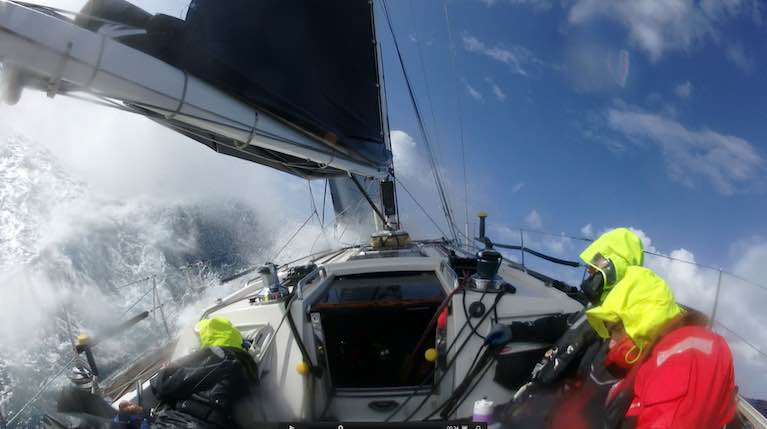Barry Hayes from UK Sailmakers Ireland with tips on the dos and don'ts of reefing a sail for racing and cruising
Times have changed, and this season we have moved to more ISORA short course, offshore sailing. This trend will probably continue into next season. With these shorter courses, having the optimal sail set-up at all times is critical. Knowing when to reef your mainsail to achieve the right balance for the boat is key to your upwind, heavy air performance. This is particularly the case as we head into winter club racing when the colder air is denser.
When to reef: racing
It is always a challenge to decide if you are better off depowering the boat with a reefed mainsail (and going through the "process" of reefing/unreefing") or waiting for the wind to lighten when your full main would be more effective. One determining factor is the size and abilities of your crew (can they quickly throw in a reef and release it when necessary) and how much weight you have on the rail (effecting how overpowered you are). The decision of when to reef is more complex than that.
If your sailing doublehanded or shorthanded, you will want to reef early. A good benchmark is reefing at 20 kts; the boat will still be relatively easy to handle and it reefing at a lower wind strength dramatically reduces the workload. If your fully crewed, your benchmark is more in the 25 kts range.

With those benchmarks in mind, every boat is a little different and when to reef has to do with the balance of the boat and how light it is. A First 34.7, for example, will go faster upwind with a reef in the main and full headsail in 20+ kts then with a full main because the s a light boat and quite tippy so you may want to reef sooner than later. For a high stability boat, like and XP 44, it's going to be into the 28 kts range before you put in a reef.
If you get a 20 – 25 kts day and you're out sailing, it's worth practising with and without a reef and seeing the difference in boat handling and boat speed. You might find it's easier to get around the course not being loaded-up and being fully under control at the marks. But again, each boat and team is different, so practice makes perfect.
How to do a racing reef quickly
When you are putting in a reef, prepare the main halyard so it's ready to go and then hoisted quickly and cleanly. It's all in the pit person's hands, so it's critical to have enough halyard ready to ease (figure a minimum of four metres for the first reef or four long arms full of slack). Usually, there is a snap shackle at the gooseneck of the mast that you clip into a soft shackle (see the photo (C) below - we use these to save weight on the sail) or ring on the luff of the sail. Then, get the halyard back up tight before you start trimming the line to get the clew locked in. We mainly use thimbles on racing sails which are lightweight and don't put excessive loads the sail's reefing line.
 A Snap shackle at the gooseneck of the mast clips into a soft shackle
A Snap shackle at the gooseneck of the mast clips into a soft shackle
Most racing boats don't bone the foot of the sail when reefing, this keeps a little shape in the foot and avoids stretching out the foot of the sail. Leaving a few inches of camber in the foot really makes a difference to the longevity of the sail.
Most racing mainsails designed for reefing come with webbing between the normal clew and the reefing clew (see the attached photos (D) below. This webbing creates a natural fold in the leach when you reef, helping protect the sail material. This also lifts the "skirt" of the main up onto the boom so it is out of the way. Additionally, this webbing massively helps reduce the amount of water that collects in the sail in heavy seas. With this webbing, you rarely need to use the reef diamonds along the reef line to tidy the sail away, making it easier set and release a reef while racing.
 Mainsails designed for reefing come with webbing between the normal clew and the reefing clew
Mainsails designed for reefing come with webbing between the normal clew and the reefing clew
When to reef: cruising
If the breeze is up, a white sail cruising reef is typically set well in advance of the passage. Making sure it's set up right in calm waters is dramatically more manageable and safer than trying to do it at sea. For slab reefing, follow the same steps as a racing reef. Get the reef tack on and then raise the halyard slightly more than snug to allow for some movement in the halyard. Then tighten the clew reef line, so it's close to the boom without crushing the sail.
I don't use the eyes under the boom to attach the reefing line as they are never in the right positions. Every time you reef, the tension is different, so the sheeting angle on the clew is always wrong with the eyes under the boom. Just take the line around the boom and back onto the reef line itself with a bowline or a timber hitch. This will give you a good clean reef every time, and a knot that can be "broken" after the pressure is taken off it.
If you're using single line reefing, then make sure all the lines are working correctly and are free to move. Setting the reefing line and marking it is key to clean single line reefing. It also lets you know your reef is set at the correct point before you raise the halyard. If you aren't sure where to mark your setting, remember that it's better to have them a little looser then tighter.
I normally have the single line reefs about 3 inches above the boom to allow space. This prevents point loading the reefing lines or causing chafe. Having a lazy cradle makes it much harder to see where your reefing lines are, so having marks on the line and the mast is recommended. Most of today's lazy cradles will roll away onto the boom and not cause any issue when reefing.
 Lazy cradles will roll away onto the boom and not cause any issue when reefing
Lazy cradles will roll away onto the boom and not cause any issue when reefing
In conclusion, if you believe your boat will be overpowered, out of balance, and harder to sail with a full main, you are better reefing. Practice this evolution, then, when it's time to do it for real, talk through what each person's role will be, what potential problems to anticipate (knots in the lines?), and confirm everyone on board is ready to execute their job before saying "go." Remember, if you're reefing it's because the boat is healing excessively, so make sure your crewmembers scurrying around the deck are wearing their PFDs and/or are tethered to the boat.



























































